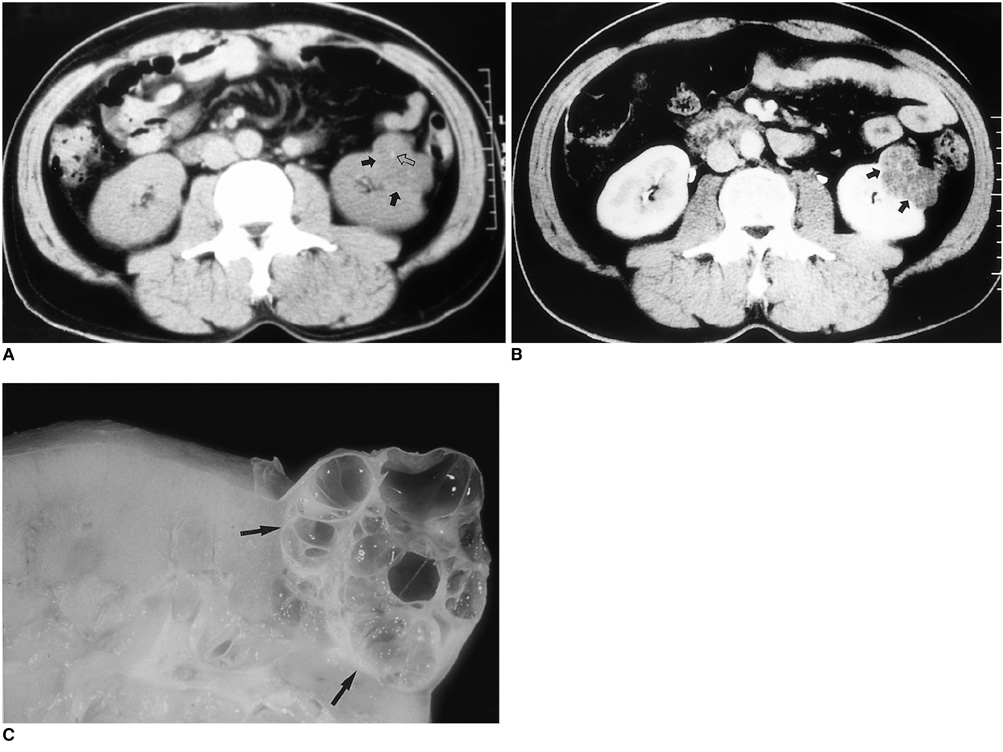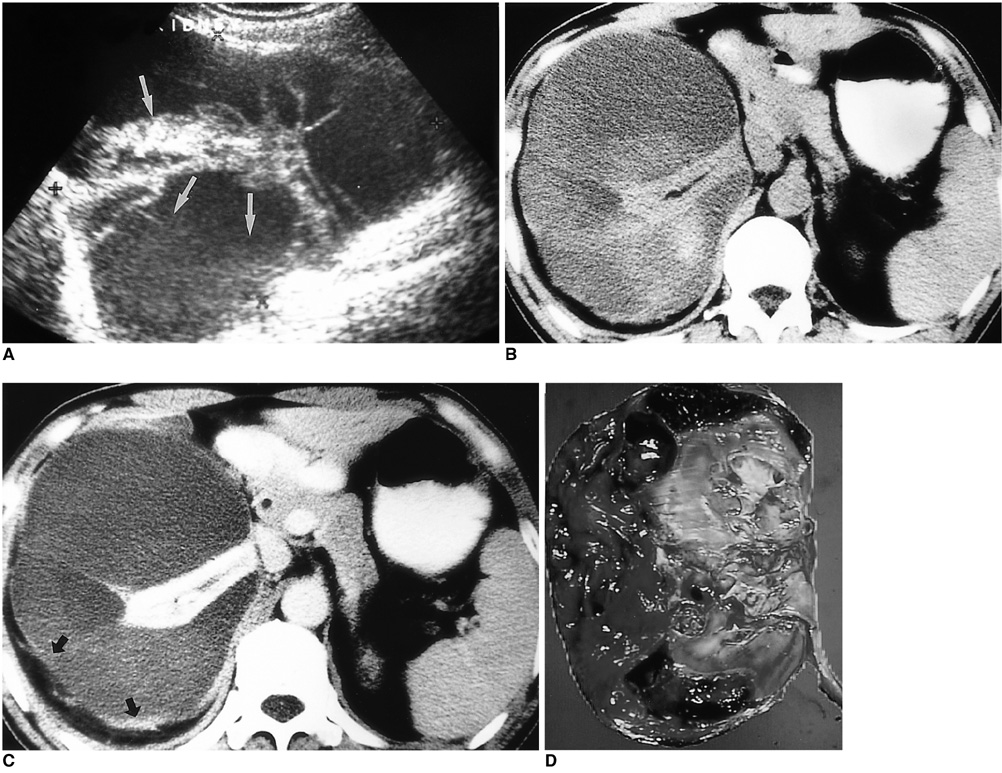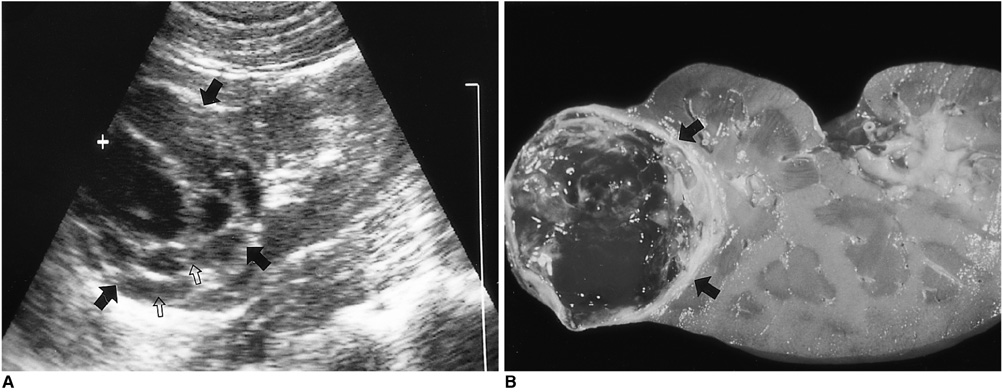Korean J Radiol.
2000 Jun;1(2):104-109. 10.3348/kjr.2000.1.2.104.
CT and US Findings of Multilocular Cystic Renal Cell Carcinoma
- Affiliations
-
- 1Department of Diagnostic Radiology, Chungnam National University School of Medicine, Taejeon, Korea. jckim@cnuh.co.kr
- KMID: 966481
- DOI: http://doi.org/10.3348/kjr.2000.1.2.104
Abstract
OBJECTIVE
Multilocular cystic renal cell carcinoma (MCRCC) is a recently described variety of renal cell carcinoma with characteristic pathologic and clinical features. The purpose of this study was to analyze the imaging findings of MCRCCs. MATERIALS AND METHODS: Ten adult patients with pathologically proven unilateral MCRCC who underwent renal US and CT were included in this study. The radiologic findings were retrospectively evaluated for cystic content, wall, septum, nodularity, calcification and solid portion by three radiologists who established a consensus. Imaging and postnephrectomy pathologic findings were compared. RESULTS: All patients were adults (six males and four females) and their ages ranged from 33 to 68 years (mean, 46). On US and CT images, all tumors appeared as well-defined multilocular cystic masses composed of serous or complicated fluid. In all patients, unenhanced CT scans revealed hypodense cystic portions, and in four tumors, due to the presence of hemorrhage or gelatinous fluid, some hyperdense areas were also noted. In no tumor was an expansile solid nodule seen in the thin septa, and in only one was there dystrophic calcification in a septum. Small areas of solid portion constituting less than 10% of the entire lesion were found in six of the ten tumors, and these areas were slightly enhanced on enhanced CT scans. In all patients, imaging and pathologic findings correlated closely. CONCLUSION: On US and CT images, MCRCC appeared as a well-defined multilocular cystic mass with serous, proteinaceous or hemorrhagic fluid, with no expansile solid nodules in the thin septa, and sometimes with small slightly enhanced solid areas. Where radiologic examinations demonstrate a cystic renal mass of this kind in adult males, MCRCC should be included in the differential diagnosis.
Keyword
MeSH Terms
Figure
Reference
-
1. Hartman DS, editor. The troublesome cystic renal mass. Proceedings of Uroradiology in Santa Fe' 97. 1997. 29–32.2. Murphy JB, Marshall FF. Renal cyst versus tumor: a continuing dilemma. J Urol. 1980. 123:566–569.3. Hartman DS, Davis CJ Jr, Johns T, Goldman SM. Cystic renal cell carcinoma. Urology. 1986. 283:145–153.4. Levy P, Helenon O, Merran S, et al. Cystic tumors of the kidney in adults: radiopathologic correlations. J Radiol. 1996. 80:121–133.5. Murad T, Komaiko W, Oyasu R, Bauer K. Multilocular cystic renal cell carcinoma. Am J Clin Pathol. 1991. 95:633–637.6. Eble JN, Bonsib SM. Extensively cystic renal neoplasms: cystic nephroma, cystic partially differentiated nephroblastoma, multilocular cystic renal cell carcinoma and cystic hamartoma of renal pelvis. Semin Diagn Radiol. 1998. 15:2–20.7. Yamashita Y, Miyazaki T, Ishii A, Watanabe O, Takahashi M. Multilocular cystic renal cell carcinoma presenting as a solid mass: radiologic evaluation. Abdom Imaging. 1995. 20:164–168.8. Feldeberg MAM, van Waes PFGM. Multilocular cystic renal cell carcinoma. AJR. 1982. 138:953–955.9. Levy P, Helenon O, Merran S, et al. Cystic tumors of the kidney in adults: radiohistopathologic correlations. J Radiol. 1999. 80:121–133.10. Bielsa O, Lloreta J, Gelabert-Mas A. Cystic renal cell carcinoma: pathological features, survival and implications for treatment. Br J Urol. 1998. 82:16–20.11. Ooi GC, Sagar G, Lynch D, Arkell DG, Ryan PG. Cystic renal cell carcinoma: radiological features and clinico-pathological correlation. Clin Radiol. 1996. 51:791–796.12. Robinson GL. Perlman's tumor of the kidney. Br J Surg. 1957. 44:620–623.13. Weiss SG 2nd, Hafez RG, Uehling DT. Multilocular cystic renal cell carcinoma: implications for nephron sparing surgery. Urology. 1998. 51:635–637.14. Madewell JE, Goldman SM, Davis CJ Jr, Hartman DS, Feigin DS, Lichtenstein JE. Multilocular cystic nephroma: a radiographic-pathologic correlation of 58 patients. Radiology. 1983. 146:309–321.
- Full Text Links
- Actions
-
Cited
- CITED
-
- Close
- Share
- Similar articles
-
- A Case of Multilocular Cystic Renal Cell Carcinoma
- A case of multilocular cystic renal cell carcinoma mistaken for multilocular renal cyst
- CT and US Findings of the Multilocular Cystic Renal Cell Carcinoma
- Multilocular Cystic Renal Cell Carcinoma: A case report
- Multilocular Cystic Renal Cell Carcinoma Treated with Wedge Resection




